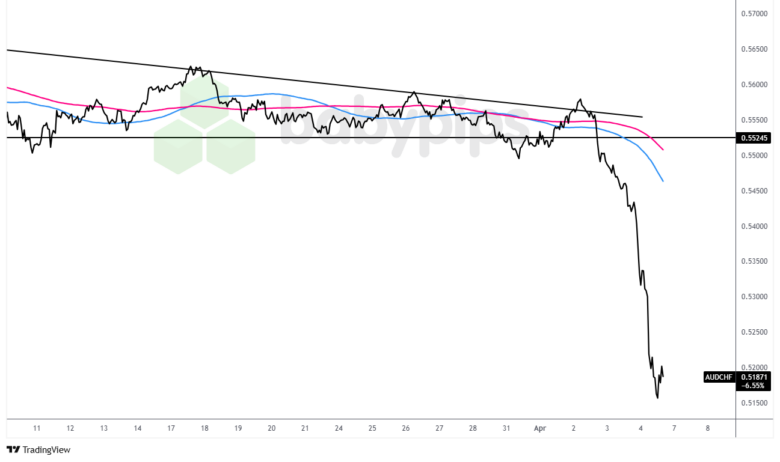This week our currency strategists focused on the RBA Monetary Policy Statement for potential high-quality setups.
Out of the four scenario/price outlook discussions this week, one discussion arguably saw both fundie & technical arguments triggered to become potential candidates for a trade & risk management overlay.
Watchlists are price outlook & strategy discussions supported by both fundamental & technical analysis, a crucial step towards creating a high quality discretionary trade idea before working on a risk & trade management plan.
If you’d like to follow our “Watchlist” picks right when they are published throughout the week, you can subscribe to BabyPips Premium.
AUD/CHF: Tuesday – March 31, 2025

AUD/CHF 1-Hour Forex Chart by TradingView
On Tuesday, our strategists had their sights set on the RBA monetary policy statement and its potential impact on the Australian dollar. Based on our Event Guide, expectations were for the RBA to keep its interest rates steady at 4.10%, with markets looking for signals on future policy direction and concerns about U.S. tariff policies. With those expectations in mind, here’s what we were thinking:
With those expectations in mind, here’s what we were thinking:
The “Aussie Quick Bounce” Scenario:
If the RBA maintained its cautiously optimistic stance on inflation or showed resistance to near-term rate cuts, we anticipated this could temporarily boost AUD but ultimately attract bearish pressure with the looming tariffs announcement. We focused on potential initial pop higher on AUD/JPY that could’ve taken the pair to near-term resistance zones or a possible AUD/CAD range resistance test in a risk-on environment, given speculations for U.S. tariffs exemptions for Canada.
The “Aussie Avalanche” Scenario:
If the RBA signaled a shift towards more aggressive rate cuts or expressed heightened growth concerns, particularly regarding U.S. tariffs and China’s economic outlook, we thought this could weigh on AUD. We considered AUD/NZD for potential short strategies in a risk-on environment, particularly given New Zealand’s improved economic indicators. If risk sentiment stayed negative, AUD/CHF short looked promising given the franc’s traditional safe-haven status amid rising trade tensions and the pair’s position near a descending triangle resistance.
What Actually Happened:
The RBA kept rates steady at 4.10% as expected and maintained a cautiously optimistic stance on inflation. Key points from the statement:
- The central bank noted that “underlying inflation is moderating” and has “fallen substantially since the peak in 2022”
- The board kept its line that policy remains “restrictive,” meaning it still sees some downward pressure on inflation
- The RBA dropped an explicit reference to being cautious about cutting rates further, which analysts interpreted as a slightly dovish signal
- The statement spent more time than usual discussing global risks, particularly the U.S. tariffs, noting “Recent announcements from the United States on tariffs are having an impact on confidence globally”
- The bank warned that wider or retaliatory measures could hurt global growth and add to inflation uncertainty
Governor Bullock reinforced a more balanced tone in her press conference, emphasizing that they cannot declare victory on inflation just yet, explaining that their February decision to ease was not a signal for a series of forthcoming reductions. She described that cut as a “difficult decision” and stressed that further cuts would depend on incoming data.
Market Reaction:
This outcome fundamentally triggered our AUD bearish scenarios, and with risk sentiment deteriorating rapidly due to global trade concerns, AUD/CHF became our pair to watch.
Looking at the AUD/CHF chart, we can see the pair initially found some support around the 0.5530 level following the RBA decision and Governor Bullock’s comments. There was a brief push higher as Bullock’s balanced tone offset the slightly dovish statement, but the pair struggled to overcome resistance at the 0.5560-75 area around the descending triangle top.
The real action began during the U.S. session on Wednesday when President Trump announced his “Liberation Day” tariffs, which were significantly higher and broader than market expectations. AUD/CHF immediately retreated from the triangle resistance then broke below support at 0.5525, confirming our bearish outlook as global risk sentiment deteriorated sharply.
By Friday, the pair had plummeted to multi-month lows around 0.5180 after China announced retaliatory measures against U.S. goods, including a 34% tariff and restrictions on rare earths exports. The Australian dollar, highly sensitive to both Chinese economic prospects and global trade flows, bore the brunt of the sell-off while the Swiss franc benefited from strong safe-haven flows.
The Verdict:
So, how’d we do? Our fundamental analysis anticipated potential AUD weakness if global trade concerns overshadowed the RBA decision, which played out in dramatic fashion. Our technical analysis correctly identified the AUD/CHF descending triangle pattern and even near-term resistance levels on other AUD pairs that contained any post-RBA bounce before the decisive breakdown.
We think this discussion “highly likely” supported a net positive outcome as both fundamental and technical triggers aligned perfectly. While the RBA itself wasn’t overly dovish, its concerns about global trade risks proved prescient just a day later when Trump’s tariff announcement triggered the AUD/CHF triangle breakdown.
Traders who entered short positions near the triangle resistance after the RBA event could have captured one of the largest weekly moves in AUD/CHF (over 6.5% drop). Even conservative profit targets would have been quickly reached, and trailing stops would have allowed for capturing the extended move as global trade tensions escalated.
The key takeaway here is that sometimes the central bank event itself merely sets the stage, while external factors provide the catalyst for the major move. In this case, the RBA’s warning about trade tensions proved remarkably timely, giving traders a valuable heads-up before the tariff announcement triggered the avalanche.
However, it’s also important to note that with “Liberation Day” proving to be the much bigger event risk and market driver, a more prudent trade management option would have been to take stock of the RBA insights and AUD implications but wait for the actual tariffs announcements before taking any positions.
